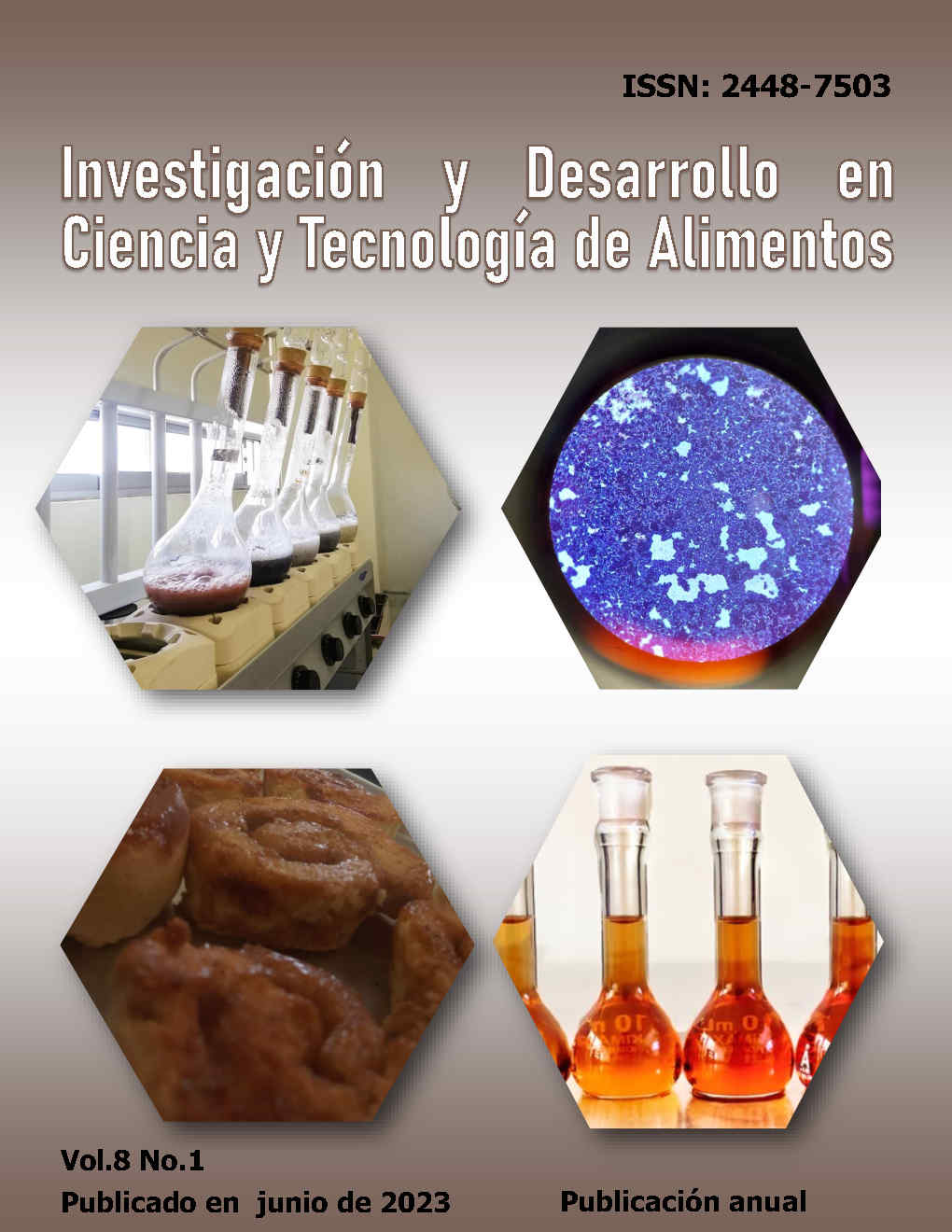Caracterización fisicoquímica y sensorial del pulque producido en la zona sur del estado de Guanajuato
DOI:
https://doi.org/10.29105/idcyta.v8i1.49Keywords:
Sensorial Analysis, pulque, descriptors, Quantitative Descriptive Analysis, physicochemical propertiesAbstract
Pulque is a traditional Mexican alcoholic beverage produced from the fermentation of the sweet sap extracted from the stems of several species of the Agave family. It is a liquid of whitish color, viscous consistency, slightly acidic, and of low alcohol content. In this study, physicochemical properties were evaluated and a sensory profile was developed through quantitative descriptive analysis (QDA) for scent, flavor, and aftertaste of pulque produced in the municipalities of Comonfort (COM), Tarimoro (TAR), and Valle de Santiago (VDS), located in the southern region of the state of Guanajuato. The results showed a significant difference (p<0.05) for TAR in pH parameters (3.68±0.01), TSS (8.46±0.05 °Bx), alcohol (4.7%), and density (1 g/mL) concerning COM and VDS. The sensory profile identified 19 distributed descriptors for scent, flavor, and aftertaste, prevailing apple (5.1±0.6), alcoholic note (4±0. 6), and apple vinegar (3.4±1) for scent; acid (5.4±0.5a), sweet (4.1±1a) and ethanol (3.5±0.5a) for flavor; and cider (3.7±0.5a) and yeast (3.1±1a and 2.6±0.5a) for the aftertaste. This suggests that the sensory and physicochemical properties could be related to the region in which the pulque is produced.
Downloads
References
Álvarez-Ríos, G. D.-U., & Casas, A. (2020). Sistemas de manejo de maguey pulquero en México. Revista Etnobiología, 18(2), 3-23.
Anderson, R. K., Calvo, J., Serrano, G., & Payne, G. (1946). A study of nutritional status and food habitats of Otomi Indians in the Mezquital Valley of Mexico. American Journal of Public Health, 36, 883-903. DOI: https://doi.org/10.2105/AJPH.36.8.883
AOAC, A. o. (2000). Official Methods of Analysis of the Association of Official Chemists (17th ed.). Gaithersburg, USA: AOAC.
Backstrand, J. R., Allen, L. H., Black, A. K., & De Mata, M. P. (2002). Diet and iron status of nonpregnant women in rural Central-Mexico. American Journal of Society for Clinical Nutrition, 76, 156-164. DOI: https://doi.org/10.1093/ajcn/76.1.156
Escalante, A., López-Soto, D., Velázquez-Gutiérrez, J., Giles-gómez, M., Bolívar, F., & López-Munguía, A. (2016). Pulque, a traditional mexican alcoholic fermented beverage: historical, microbiological, and technical aspects. Frontiers in Microbiology, 7(1026), 1026-1044. DOI: https://doi.org/10.3389/fmicb.2016.01026
Escalante, A., Giles-Gómez, M., Hernández, G., Córdova-Aguilar, M. S., López-Munguía, A., Gosset, G., & Bolívar, F. (2008). Analysis of bacterial community during the fermentation of pulque, a traditional Mexican alcoholic beverage, using a polyphasic approach. International Journal of Food Microbiology, 124, 126-134. DOI: https://doi.org/10.1016/j.ijfoodmicro.2008.03.003
Hernández, F. (2007). La alimentación de los antiguos mexicanos en la Historia natural de la Nueva España. Distrito Federal, México: Universidad Nacional Autónoma de México.
Herrera-Solorzano, M. C. (2008). Identificación polifásica de levaduras y bacterias ácido lácticas aisladas de aguamiel, pulque y semilla. Ensenada: Centro de Investigación Científica y de Educación Superior de Ensenada.
Meilgaard, Morten C., Civille, Gail V. y Thomas Carr, B. (2016). Sensory Evaluation Techniques. Nueva York: Taylor & Francis Group. Quinta ed.
Matías-Luis, G., Peña-Caballero, V., Reyna-González, W., Domínguez-Díaz, L. R., & Martínez-Hernández, J. J. (2019). Nutritional and medicinal value of pulque. JONNPR, 4(12), 1291-1303.
Rivas-Hilario, C. (2014). Desarrollo del perfil sensorial del pulque. Tesis de Licenciatura, Universidad Nacional Autónoma de México, Facultad de Química, México, D.F.
Rojas-Rivas, E., Viesca-González, F., Espeitx-Bernat, E., & Quintero-Salazar, B. (2016). El maguey, el pulque y las pulquerías de Toluca, Estado de México, ¿patrimonio gastronómico turístico? PASOS, 14(5), 1199-1215. DOI: https://doi.org/10.25145/j.pasos.2016.14.080
Rojas-Rivas, E., Viesca-González, F. C., Favila-Cisneros, H. J., & Cuffia, F. (2020). Consumers´s perception of a traditional fermented beverage in Central Mexico: An exploratory study with the case of pulque. British Journal Food, 122(2), 708-721. DOI: https://doi.org/10.1108/BFJ-05-2019-0317
Steinkraus, K. (1997). Handbook of indigenous fermented food (Segunda ed.). New York: Mardel Dekker.
Downloads
Published
How to Cite
Issue
Section
License
Copyright (c) 2023 E. Flores-Rodríguez , R. Miranda-López

This work is licensed under a Creative Commons Attribution 4.0 International License.
Los autores/as que publiquen en esta revista aceptan las siguientes condiciones:
a. Los autores/as conservarán sus derechos de autor y garantizarán a la revista el derecho de primera publicación de su obra, el cual estará simultáneamente sujeto a la Licencia Creative Commons Atribución 4.0 Internacional. que permite a terceros compartir la obra siempre que se indique su autor y su primera publicación esta revista.
b. Los autores/as pueden realizar otros acuerdos contractuales independientes y adicionales para la distribución no exclusiva de la versión del artículo publicado en esta revista (p. ej., incluirlo en un repositorio institucional o publicarlo en un libro) siempre que indiquen claramente que el trabajo se publicó por primera vez en esta revista.
c. Se permite y recomienda a los autores/as a publicar su trabajo en Internet (por ejemplo en páginas institucionales o personales) posterior al proceso de revisión y publicación, ya que puede conducir a intercambios productivos y a una mayor y más rápida difusión del trabajo publicado.





